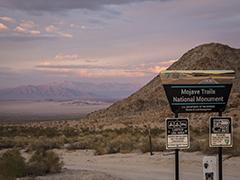California Desert District Advisory Council to meet virtually
Organization:
BLM Office:
Media Contact:
Palm Springs, Calif. — The Bureau of Land Management California Desert District Desert Advisory Council (DAC) will meet virtually via Zoom this Saturday, Oct.2, from 9 a.m. to 4:30 p.m.
Meeting agenda topics include national monument planning, a discussion on subgroups, and updates on bighorn sheep and a presentation about desert springs, as well as overviews from the district, field offices, and fire and fuels operations. The final meeting agenda can be found on the DAC webpage.
The meeting is open to the public and participants must register prior to attending at https://bit.ly/3ihCw8F. After registering, participants will receive a confirmation email with instructions, a link to join the meeting and phone numbers for those unable to join online. Zoom virtual meeting tutorials can be viewed here.
The public will be given an opportunity to address DAC members during the public comment period at 2:45 p.m. Time for individual public comments may be limited due to the number of individuals wishing to speak. Written statements to address the DAC may also be mailed prior to the meeting to the BLM California Desert District Office, 1201 Bird Center Drive, Palm Springs, CA 92262, Attention: Michelle Van Der Linden/DAC meeting comments or emailed to [email protected].
To learn more about the DAC and upcoming meetings, visit https://go.usa.gov/xMUkB. For specific meeting questions, please contact BLM California Desert District Public Affairs Officer Michelle Van Der Linden at [email protected].
The BLM manages about 245 million acres of public land located primarily in 12 western states, including Alaska, on behalf of the American people. The BLM also administers 700 million acres of sub-surface mineral estate throughout the nation. Our mission is to sustain the health, diversity, and productivity of America’s public lands for the use and enjoyment of present and future generations.

